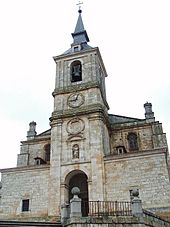Colegiata San Pedro (Lerma)

The Roman Catholic Colegiata San Pedro in the Spanish municipality of Lerma is one of the most important buildings in the Herrerianismo style , which shaped the age of the Counter Reformation at the end of the 16th and beginning of the 17th centuries .
history
The uncle of Francisco Gómez de Sandoval y Rojas (1553-1625), the Marqué of Denia and Duke ( duque ) of Lerma, was the former Archbishop of Seville , Cristóbal de Rojas y Sandoval (1502-1580). While he was still alive, he had infected his nephew with his idea of Lerma, because he wanted to be buried here, to equip it with a large collegiate church ; Appropriate funds were certainly also available and so he took up the idea - about twenty years after the death of his uncle as the now Duke of Lerma. He chose the small parish church of San Pedro as a suitable property for the necessary demolition and subsequent new construction; however, their patronage remained. A decree by Pope Paul V with the name nullius diocesis in 1606 confirmed the independence of the collegiate church from the Archdiocese of Burgos and its direct subordination to the Holy See .
architecture
facade
The building plans come from the monk architect Fray Alberto de la Madre de Dios , who was based on the strict style of the Escorial and largely dispensed with any kind of architectural decoration. Nevertheless, the single-tower facade is clearly structured by vertical corner pilasters and horizontal cornices than that of the Ducal Palace ( Palacio Ducal de Lerma ) about 300 meters away : Above the simple round arch of the entrance portal there is a niche with the statue of the Apostle Peter; this is inflated from a blend gable in lunette with two side beads which form the attachment for a stone family crest, which is framed by a ring of flowers and fruit.
Another, similarly designed but towerless entrance portal can be found on the south side of the building, where the former cloister area and its cloister ( claustro ) were located. The latter may have been demolished in 1835 as part of the dismortment of the Spanish church property .
inner space
The interior of the three-aisled church is almost 68 meters long and 23 meters wide. The central nave and the two side aisles are about the same height (approx. 15.50 meters) and vaulted by intricate star vaults in the late Gothic style , the keystones of which are designed as coats of arms and flowers.
Furnishing
On a pedestal in the north arm of the transept is the almost life-size kneeling statue of the donor Don Cristóbal de Rojas y Sandoval in front of a lectern , which is covered by a richly decorated blanket and a pillow on which there is an open Bible. The head of the founder is uncovered; hands are clasped in prayer. The bishop's staff and cap are placed to the right of the donor statue. The figure of the donor as well as all objects are made of thin bronze sheets in relief, which have been processed and soldered together in such a way that everything seems to be made of one piece. The figure is in direct artistic and technical-technical relation to the similarly designed donor portraits in the church of the Escorial and probably comes from the workshop of Juan de Arfes . The Duke of Lerma may have had it transferred to the old parish church as early as 1608.
Also noteworthy are the multi-seated choir stalls ( sillería ) from around 1615 and the large gold-framed altarpiece in the choir area - however, it was not included in the original planning and was only added towards the end of the 17th century. It is made in the opulent style of the Spanish Baroque and stands - like the two small altars in front of the two transept pillars at the end of the central nave - in clear contrast to the clear lines of the architecture. The two organs opposite from the period around 1615–1617 are also artistically and historically significant; they are possibly the oldest in the Iberian Peninsula . In the sacristy of the church there are other art treasures, including a precious square inlay table - a gift from Paul V from Italy. The oldest piece of equipment is a Romanesque baptismal font from the 13th century; its decoration is not very sacramental - in the lush foliage, which perhaps refers to the tree of life , there are centaurs , lions, griffins and other birds.
Central nave and choir with altarpiece
sightseeing
Visiting the church is only possible as part of a tour through the local tourist office ( oficina del turismo ).
Web links
- Colegiata San Pedro (Lerma) - Photos + Info (Spanish)
- Colegiata San Pedro (Lerma) - Photos + Info (Spanish)
- Colegiata San Pedro (Lerma), organs - photos + information (Spanish)
Coordinates: 42 ° 1 ′ 35.8 " N , 3 ° 45 ′ 29.9" W.





